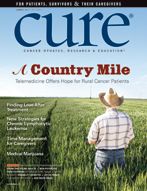Publication
Article
CURE
Diagnosis on a Chip? No Longer Science Fiction
Author(s):
House call with Len Lichtenfeld, the deputy chief medical officer of the American Cancer Society.
Photo Courtesy of Len Lichtenfeld, MD

Len Lichtenfeld, MD, is deputy chief medical officer of the American Cancer Society. [Photo Courtesy of Len Lichtenfeld, MD]
Q: How much can doctors figure out about our cancer status just by analyzing our blood? Shouldn’t the answers be right there, without more invasive testing, if we just knew how to find them?
A: About 10 years ago I attended a cancer conference where one of the speakers talked about the future of cancer care and mentioned “diagnosis on a chip.” An intriguing idea at the time bordering on science fiction, he predicted that within the next decade we would be able to take a drop of blood at home and send it for analysis to a lab that would screen for cancer and other chronic diseases.
Now, according to several reports appearing recently in medical journals, it looks like that brave new world may not be far off.
Researchers have reported they have been able to detect what are called “cell free DNA” fragments in the blood of patients with head and neck cancer and pancreatic cancer. Another report detailed how testing the blood of pregnant women for birth defects in their offspring found evidence of cancer in the mothers — sometimes even before that cancer had been detected clinically. And yet another researcher briefly mentioned, at a meeting I recently attended, that a pharmaceutical company was monitoring DNA signals in the blood of patients participating in an early-stage drug trial, finding evidence of how the patients’ cancer cells were mutating in real time to evade the new targeted therapy under investigation in the trial.
This is all truly amazing research. But before we get carried away, it is important that we pay attention to what we know — and what we don’t know — about this new frontier in screening and treating cancer.
First and foremost, this research is still in very early stages when one considers its applications to cancer care. Researchers have shown they can find the DNA signals in the blood and other bodily fluids. That does not mean that such tests are ready for widespread use. Then there are the studies that must be done to determine how to best use this information to inform the care that we offer our patients. It is likely to take much more effort and perhaps a number of years before we have widely available clinical applications for these exciting discoveries.
As always, caution is the word. There will always be someone out there who wants you to believe they have a test that is better than what everyone else can offer. That rarely is the case. Before we start using this technology to screen or diagnose or treat cancer, we need to make certain we understand not only the power of the science, but its limitations as well






